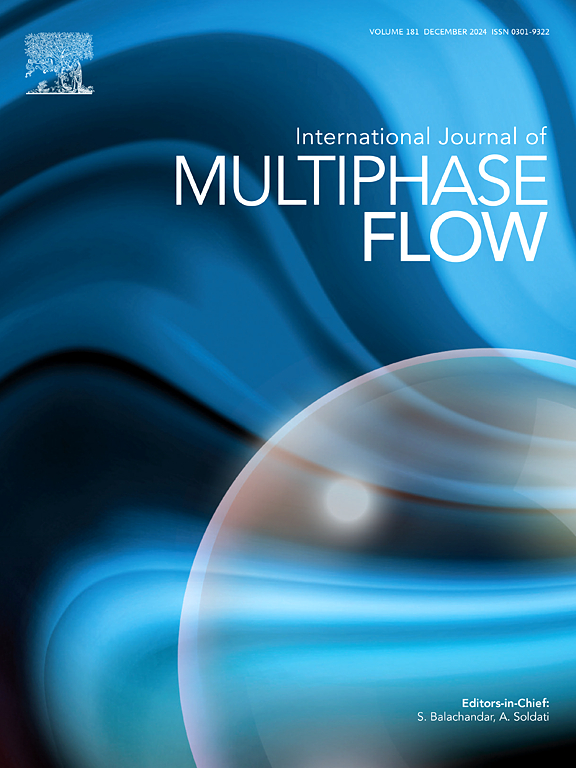Frictional losses in a bubbling fluidized bed with horizontal flow of solids
IF 3.6
2区 工程技术
Q1 MECHANICS
International Journal of Multiphase Flow
Pub Date : 2025-02-22
DOI:10.1016/j.ijmultiphaseflow.2025.105192
引用次数: 0
Abstract
This study investigates the frictional losses in a horizontal flow of solids fluidized under bubbling conditions, relevant to applications like combustion, gasification, drying, and waste incineration. Experiments were conducted in a fluid-dynamically down-scaled setup simulating a bed of Geldart type B solids, fluidized under typical industrial conditions for thermochemical conversion processes, corresponding to sand (particle density: 2650 kg/m3; diameter: 950 µm) fluidized with air/flue gas at 900 °C. The rig features a bubbling bed with a closed horizontal loop for controlled solids circulation, equipped with in-bed pressure probes to measure horizontal pressure drop. Horizontal solids velocity was evaluated by performing magnetic solids tracing experiments. Key parameters varied included solids velocity (0–0.10 m/s), channel width (0.58–1.0 m), and settled bed height (0.67–0.83 m).
The results clearly indicate a horizontal pressure gradient (15–485 Pa/m), which is proportional to the solids' mean velocity (0–0.101 m/s in upscaled terms). An inverse relationship between the pressure gradient and channel width was also identified. Rheological analysis indicates shear-thinning behavior, with wall shear stress ranging from 10 to 140 Pa for shear rates of 2 × 10−3–0.45 s−1 (on an up-scaled basis). Existing models for non-Newtonian flow were found to underestimate the impact of geometric parameters. An alternative correlation is proposed, and friction coefficients are calculated. Analysis of friction coefficients against the Reynolds number confirms laminar flow. Additionally, a strong positive correlation between the generalized Reynolds and Péclet numbers highlights the impact of viscous forces in solids mixing. Lastly, the friction factor analysis, based on granular flow rheology, indicates that friction dynamics occur within the dense flow regime.

具有固体水平流动的鼓泡流化床的摩擦损失
本研究研究了鼓泡条件下流化固体水平流动中的摩擦损失,与燃烧、气化、干燥和垃圾焚烧等应用相关。实验在模拟Geldart B型固体床的流体动力学缩小装置中进行,该床在典型工业条件下进行热化学转化过程的流化,对应于砂(颗粒密度:2650 kg/m3;直径:950微米)在900°C下与空气/烟气流化。该钻井平台具有一个鼓泡床,具有一个封闭的水平循环,用于控制固体循环,并配备了床内压力探头来测量水平压降。通过磁性固体示踪实验对水平固体速度进行了评价。关键参数变化包括固体流速(0 ~ 0.10 m/s)、通道宽度(0.58 ~ 1.0 m)和沉降层高度(0.67 ~ 0.83 m)。结果表明,水平压力梯度(15 ~ 485 Pa/m)与固体平均流速(0 ~ 0.101 m/s)成正比。压力梯度与通道宽度呈反比关系。流变分析表明,剪切变薄行为,当剪切速率为2 × 10−3-0.45 s−1时,壁面剪切应力范围为10至140 Pa。发现现有的非牛顿流体模型低估了几何参数的影响。提出了另一种相关性,并计算了摩擦系数。摩擦系数对雷诺数的分析证实了层流的存在。此外,广义雷诺数和psamclet数之间的强正相关关系突出了粘性力在固体混合中的影响。最后,基于颗粒流动流变学的摩擦因子分析表明,摩擦动力学发生在致密流动区。
本文章由计算机程序翻译,如有差异,请以英文原文为准。
求助全文
约1分钟内获得全文
求助全文
来源期刊
CiteScore
7.30
自引率
10.50%
发文量
244
审稿时长
4 months
期刊介绍:
The International Journal of Multiphase Flow publishes analytical, numerical and experimental articles of lasting interest. The scope of the journal includes all aspects of mass, momentum and energy exchange phenomena among different phases such as occur in disperse flows, gas–liquid and liquid–liquid flows, flows in porous media, boiling, granular flows and others.
The journal publishes full papers, brief communications and conference announcements.

 求助内容:
求助内容: 应助结果提醒方式:
应助结果提醒方式:


